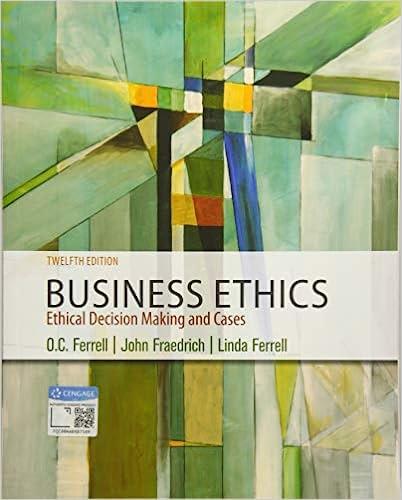Connor graduated from Southern Arizona University with a BS in operations and logistics after he came back
Question:
Connor graduated from Southern Arizona University with a BS in operations and logistics after he came back from his tour in the army. His work in the army prepared him well as a manager in operations and logistics, and it showed when he was hired at AlumaArc, a manufacturing facility that produced various tank parts for the U.S. Army.
Connor’s coworkers and fellow managers at his company respected him for the proficiency he showed in his work.
Within 18 months he became the key person in the logistics department, and a few months after that Connor became one of 20 managers in charge of the third shift. Above him were two assistant general managers (AGMs) and the general manager. The plant employed 2,000 general workers and several hundred specialists.
Recently, the U.S. Army asked AlumaArc to step up production. This meant adding another shift with existing personnel and a number of incentives for increased productivity. At first, Connor was happy with the new business AlumaArc was getting. However, as he began examining the amount of output required to meet the army’s expectations, he grew concerned. Even with overtime, the plant would still find it difficult to meet output goals running at maximum capacity. He also noticed many of the workers appeared worn out.
Because the plant had heavy equipment that required workers to take several safety precautions, it was standard procedure for workers to fill out a checklist marking off the different safety requirements before they began operating the machinery. One day Connor noticed the checklist for his shift hadn’t been filled out. He asked Joe, one of the employees, about why it hadn’t been done.
“Oh, we’ve been so busy lately trying to meet our production quota that George told us we could just skip it,”
Joe explained. George was one of the AGMs.
“But these checklists are used to make sure you’re operating everything safely,” Connor responded.
Joe looked grim. “Well, if we filled them out, we’d just be lying anyway.” He informed Conner that to save time, the workers were encouraged to bypass standard safety procedures. Additionally, Connor was horrified to realize many of the workers were not taking their required breaks in order to get rewarded for increasing their output.
Later that day, Connor confronted George. “George, these incentives are encouraging careless and unsafe behaviors. Employees are skipping safety procedures and breaks to get the work done. It’s only a matter of time before someone gets seriously hurt.”
George looked firmly at Connor. “I realize there are potential risks, but we can’t afford to hire additional workers right now. If we can just meet this output, it’ll increase our business 10-fold. We’ll be able to hire new workers and pay our current employees more.”
Connor was stunned. “But these are people we are putting at risk!”
George sighed. “Connor, each worker has a choice whether or not they take advantage of these incentives.
They are not being forced to do anything they don’t want to do. Besides, these are not my rules. The GM put these incentives in place. It’s really out of my control. Just think about it. We’re doing it for the greater good of our company and our employees.”
Connor replied, “But if they refuse, they are probably afraid they’ll lose their jobs. And even if they do feel the risks are worth it, isn’t it our job to make sure they have safe work conditions?”
Although George continued to reassure him, Connor left George’s office determined to enforce all safety protocols and force his employees to take their required breaks. He figured if top management would not consider the well-being of the employees, he would do what he could to protect those who fell under his authority.
Later that week, George came up to Connor and said,
“I’m sorry to tell you this, but your shift is not meeting the required output levels. We need to meet these deadlines quickly and accurately, and your shift has always been our fastest. Without you we’re never going to get the work done on time. That means we’ll have to start laying off employees who aren’t performing up to expectations.”
Connor recognized George’s veiled threat but refused to compromise his workers’ safety. Meanwhile, he began hearing stories of employees getting injured on other shifts.
Connor decided to talk to Wendy Smith, the general manager. He knew she probably was not pleased with him, but he felt it necessary to try to persuade her about the dangers of what the company was doing. Connor wondered how he should approach Wendy. If he was not careful, she could fire him. He did not want to be disrespectful, but he also didn’t want to be a part of a company that knowingly put their employees in harm’s way.
Questions:-
1. Describe Conner’s moral dilemma.
2. In AlumaArc’s reasoning, the benefits of increasing production outweigh the risks of potential injuries. How could this approach potentially backfire?
3. How should Connor approach this issue?
Step by Step Answer:

Business Ethics Ethical Decision Making And Cases
ISBN: 9781337614436
12th Edition
Authors: O. C. Ferrell, John Fraedrich, Linda Ferrell





